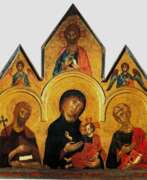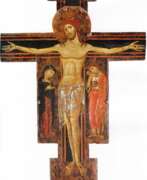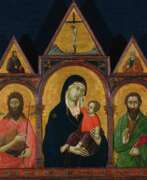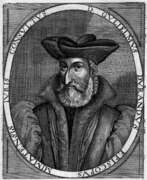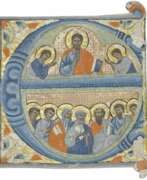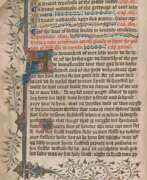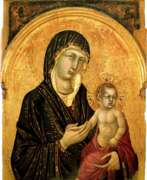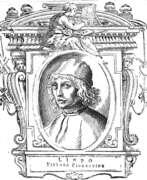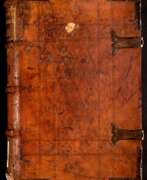13th century


Thomas Aquinas (Italian: Tommaso d'Aquino, also called Aquinas, alias Doctor Angelicus) was an Italian poet and theologian, philosopher, and major medieval scholastic.
Thomas Aquinas is one of the most important theologians in the history of Western civilization, given the extent of his influence on the development of Roman Catholic theology since the fourteenth century. As a theologian, in his two masterpieces, Summa theologiae and Summa contra gentiles, he created the classical systematization of Latin theology, and as a poet, he wrote some of the most serious and beautiful Eucharistic hymns in the church liturgy. Thomas Aquinas is recognized by the Roman Catholic Church as the foremost Western philosopher and theologian and canonized as a saint.


Henry of Bracton (also Henry de Bracton, Henricus Bracton, Henry Bretton) was an English medieval jurist, royal judge, and compiler of the English common law. Bracton came from a wealthy family from Devon and studied at Oxford University and held various ecclesiastical offices, finally becoming Chancellor of the Diocese of Exeter. Bracton also received a legal education, and entered first the service of the famous judge William Raleigh, and in 1239 went into the service of King Henry III. In 1244 Bracton became a judge himself, and in 1255-56 he was a member of the King's Council.
Henry Bracton is famous for his two works, De legibus et consuetudinibus Angliae (On the Laws and Customs of England) and Note Book, which together represent one of the most important attempts to streamline and rationalize English medieval common law. The author constructed his works inspired by compilations of Lombard law and Roman civil law. In his first classical treatise, among other things, Bracton introduced the concepts of mens rea (criminal intent) and precedent. Bracton's work, written probably between 1250 and 1260, was cited in court until the eighteenth century.


Cimabue, a preeminent Italian painter and mosaicist from the late 13th century, remains a pivotal figure in the transition from the Byzantine to the early Renaissance art style. Born before 1251 and passing in 1302, his works are celebrated for their innovative departure from the Italo-Byzantine conventions, introducing more naturalistic forms and expressions into Western European painting. This transformative approach is evident in his frescoes in the Basilica of San Francesco, Assisi, and the Santa Trinita 'Maestà' now housed in the Uffizi Gallery, Florence.
Cimabue's significance in art history is underscored by his role in laying the groundwork for the evolution of Italian painting, marking a critical moment when artists began exploring the depiction of three-dimensional space and the naturalistic rendering of forms. His influence extended to his contemporaries and successors, notably Giotto, who is often credited with advancing the Renaissance style that Cimabue initiated.
One of Cimabue's most notable works, the Santa Trinita 'Maestà', exemplifies his mature style with its refined use of perspective and more humanistic portrayal of figures, moving away from the rigid Byzantine models. This painting, alongside his frescoes in Assisi and the mosaic of 'Saint John the Evangelist' in Pisa's cathedral, demonstrates his pioneering role in the early Italian Renaissance. Despite being eventually eclipsed by Giotto, Cimabue's legacy as a bridge between Byzantine traditions and the nascent Renaissance cannot be understated.
Cimabue's artwork not only represents a crucial pivot in art history but also continues to captivate collectors and experts in art and antiques for its historical significance and the foundational role it played in the development of Western art. For those keen on exploring the origins of Renaissance art, Cimabue's works offer invaluable insights into the period's artistic evolution.
For aficionados and connoisseurs deeply engaged in the realms of art history and antique collection, particularly those with a keen interest in the seminal period that bridges the Byzantine and Renaissance eras, staying informed on Cimabue's artistic legacy is invaluable. To this end, we cordially invite you to subscribe to our dedicated updates. This subscription service is designed to provide enthusiasts with exclusive notifications about new discoveries, forthcoming sales, and prestigious auction events directly related to Cimabue's remarkable oeuvre. Engage with us to ensure you remain at the forefront of significant developments and opportunities to enhance your collection with works from this foundational figure in art history.


Giotto di Bondone, an Italian painter and architect, emerged as a pivotal figure in the transition from medieval to Renaissance art. His mastery in painting is best exemplified in the Scrovegni Chapel in Padua, also known as the Arena Chapel, where his fresco cycle depicting the Life of the Virgin and the Life of Christ is considered a seminal work of the Early Renaissance. This chapel, completed around 1305, highlights Giotto's innovative approach to art, breaking away from the Byzantine style that dominated the period. His techniques in depicting life and emotion in his works were revolutionary, setting a new direction in Western art.
Despite his acclaimed works, many aspects of Giotto's life remain shrouded in mystery and controversy, including his exact birthplace and the full extent of his apprenticeship. Traditionally believed to have been born in a farmhouse in either Colle di Romagnano or Romignano, recent research suggests he was born in Florence, the son of a blacksmith. His birth year is also uncertain, with estimates ranging from 1266/67 to 1276.
Giotto's early life, as narrated by Giorgio Vasari, is filled with anecdotal charm. He was supposedly discovered by the renowned Florentine painter Cimabue while drawing pictures of his sheep on a rock, so lifelike that Cimabue immediately recognized his talent. This encounter led to Giotto's apprenticeship under Cimabue, although this story, like many others about his early life, is debated by scholars.
In addition to the Scrovegni Chapel, Giotto's notable works include the decoration of various chapels and churches across Italy, such as in Assisi, Rome, Florence, and Naples. His Crucifixion panel and the Nativity scene are particularly celebrated for their depth and emotional intensity. Giotto was also an architect; in 1334, he was chosen to design the campanile of the Florence Cathedral, reflecting his reputation as a foremost artist.
Giotto's influence extended beyond his lifetime, inspiring future Renaissance artists with his naturalistic representation of human figures and his skill in conveying perspective and emotion. His works in the Peruzzi Chapel in Florence, particularly the Life of St. John the Baptist, are examples of this legacy.
In summary, Giotto di Bondone stands as a monumental figure in art history, his contributions marking the dawn of the Renaissance and forever altering the course of Western art. His ability to infuse his works with realism and emotional depth set a new standard in artistic expression, influencing generations of artists to come.
For those interested in the art and history of Giotto di Bondone, updates on new product sales and auction events related to his work are available. Sign up to stay informed about these opportunities and to deepen your appreciation of this pivotal artist's legacy.


Duccio di Buoninsegna, a master Italian painter from the late 13th and early 14th centuries, is celebrated as a pivotal figure in the Sienese school of painting. His birth and career in Siena profoundly influenced Italian medieval art, especially through his integration of the Italo-Byzantine tradition's formality with the Gothic style's emerging spirituality.
Duccio di Buoninsegna’s artworks are predominantly wood panel paintings, utilizing egg tempera and gold leaf, reflective of the period's artistic practices. His innovative approach is noted for its delicacy and precision in tempera, a marked contrast to the techniques of his contemporaries. Duccio di Buoninsegna is credited with softening the rigid lines of Byzantine art, rendering figures more rounded and three-dimensional, and employing modeling to enhance light and shadow effects, lending depth and realism to his subjects.
Among Duccio di Buoninsegna’s most significant works are the "Rucellai Madonna" at the Galleria degli Uffizi and the "Maestà", an altarpiece for Siena Cathedral. These dated and major public commissions, particularly the Maestà, created between 1308 and 1311, stand out as extraordinary achievements. The Maestà is a large and complex altarpiece, painted on both sides with about eighty separate scenes, showcasing Duccio di Buoninsegna’s intricate and detailed style.
Duccio di Buoninsegna's influence extended to numerous artists, including Simone Martini and the brothers Ambrogio and Pietro Lorenzetti. He had several followers, ranging from actual pupils in his workshop to artists simply inspired by his style. This includes artists from the first generation of followers active between 1290 and 1320, and a second generation active between about 1300 and 1335. His influence continued to shape Sienese and Tuscan painting well after his death.
For art collectors and experts, Duccio di Buoninsegna’s work represents a critical moment in Western art's evolution. His nuanced approach to religious themes and pioneering techniques make his works highly valued in the art and antiques world.
If you are passionate about the history and works of Duccio di Buoninsegna, consider signing up for updates. This subscription will keep you informed about new product sales and auction events related to Duccio di Buoninsegna's art, ensuring you stay connected to the legacy of this remarkable Sienese master.


Tino di Camaino was an Italian sculptor.
He was a pupil of Giovanni Pisano, whom he helped work on the façade of the Cathedral of Siena. Later Tino followed his master to Pisa, where in 1311 he became responsible for the work on the cathedral.


Master Badia a Isola (Italian: Maestro di Badia a Isola) was an Italian anonymous painter of the Sienese school who worked in and around Siena in the late 13th and early 14th centuries.
The conditional name of the master comes from the large icon "Madonna on the throne with a child and two angels" (Maesta), which used to be in the church of St Salvatore and Sirin in Badia a Isola in Monteriggioni.
Researchers believe that the Master of Badia a Isola belonged to the inner circle of the great Duccio di Buoninsegna, and was in the first rank of his pupils and followers. It is assumed that he worked in the workshop in the early period of Duccio's work. His works have direct parallels with those of Ugolino di Nerio, especially in the delicate contours of the figures and the sweet faces of the Madonnas.




Joachim of Fiore, also known as Joachim de Fiore, and Gioacchino da Fiore, was an Italian mystic, theologian and philosopher of history, a great medieval thinker with a beautiful symbolic imagination.
Fiore was a prolific writer and explored the hidden meaning of the life of the apostles and the scriptures. At the end of the twelfth century Joachim had a high international reputation.
After a pilgrimage to the Holy Land, he became a Cistercian monk and by 1177 had become abbot at Corazzo, Sicily. He retired to the mountains to lead a contemplative life, and in 1196 he founded the Order of San Giovanni in Fiore. In his Book of the Harmony of the New and Old Testaments, Fiore set forth a theory of history and traced correspondences in the Old and New Testaments. In "An Exposition of the Apocalypse" he explored the symbols of the Antichrist, and in "The Ten-String Psalter" he set forth his doctrine of the Holy Trinity. A man of vivid imagination, he was proclaimed a prophet and condemned as a heretic.
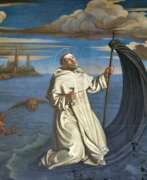

Raymond of Penyafort (Spanish: San Raimundo de Peñafort) was a Spanish theologian, canonist, and Dominican friar who is revered as a saint in the Catholic Church.
Raimondo was an adviser and confessor to the Pope in Rome as well as to kings, particularly James I of Catalonia and Aragon. Together with King James of Aragon and St. Peter Nolasco, he founded the Order of Our Lady of Ransom. The monks of this Order devoted themselves to saving Christians captured by the Moors. One of Raimondo of Peñafort's main goals was the conversion of Jews and Muslims to Christianity, and to achieve this goal he ordered Arabic and Hebrew to be studied and taught in the higher schools run by the Dominicans. He was also among those who founded the Inquisition in Catalonia.
Raimondo died at the age of 100 in Barcelona in 1275 and was canonized by Pope Clement VIII in the same year.


William of Rennes was a 13th-century French Roman Catholic monk, poet, theologian, and expert in canon law.
His commentaries and annotations on the works of the revered Catholic saint Raymond of Peñafort enjoyed almost equal authority in most manuscripts and early editions on academic theology and canon law. William of Rennes also wrote the epic of King Arthur, which is of interest to scholars of literature in that it was the first attempt to transform a medieval hero into a hero of classical eras.


Hugo Spechtshart von Reutlingen, also Hugo von Reutlingen or Hugo Spechtshart, was a German chronicler, educator and priest.
A member of a wealthy family in Reutlingen, Hugo Spechtshart was dean and later chaplain at Marienkapelle. He is known as the author of a chronicle from Roman times to the 14th century in Latin verse. The museum in St. Petersburg, Russia, has his chronicle manuscript with Geisslerlieder melodies sung in the plague year of 1349.


Johannes von Valkenburg was a Franciscan monk of the Friars Minor in Cologne, a calligrapher and illustrator.
He is known for having written, decorated and illustrated a manuscript for the Franciscan monastery in Cologne at the end of the 13th century and for having made two copies of it. One is in the Archdiocesan Diocesan and Cathedral Library in Cologne, the other in the University and State Library in Bonn. On the title pages of these rarities is an inscription indicating Valkenburg's authorship.
















